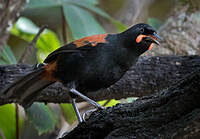South Island Saddleback
Philesturnus carunculatus - Créadion rounoir
Identification
It is a medium-sized songbird, endemic to the South Island of New Zealand, easily recognizable due to its characteristic plumage - black with a russet saddle on the back, without a golden border around the saddle. It has orange-red wattles developed at the corners of the beak. Males tend to have larger wattles than the female. Juveniles have a brown-chocolate plumage in the first year, their wattles are small and almost impossible to see. The two sexes can be distinguished only by differences in behavior.
Subspecific information monotypic species
Foreign names
- Créadion rounoir,
- Tieke de Isla Sur,
- pássaro-selado-do-sul,
- Südinsel-Sattelvogel,
- nyerges madár,
- Zuidelijke Zadelrug,
- Sellarossa,
- sydövårtkråka,
- Sørsadelrygg,
- laločník tieko,
- laločník sedlatý,
- Saddelryg,
- tiiki,
- tieke de l'illa del Sud,
- kurobród siodłaty,
- Тико,
- セアカホオダレムクドリ,
- 鞍背鸦,
- sydövårtkråka,
- 南島鞍背鴉,
Voice song and call
The call is a loud cheet te-te-te-te emitted during the day. Males have a rhythmic territorial song which is characterized by 2-4 introductory notes followed by a series of very stereotyped and repeated phrases. More than 200 different types of rhythmic songs have been recorded for males. Its vocalizations are loud, with a widely open beak. They can be described as cheeet ta-ta-chet chet-chet or ta cheee cheee cheee. Some territorial vocalizations are often shared between neighbors participating in territorial defense as well as group cohesion.
Habitat
Behaviour character trait
The South Island Saddleback is sedentary and monogamous. Couples are usually together for life and occupy the same territory throughout that time. During the breeding season, the male performs the typical archangel display and leads the female to the nest site. Offerings are also made, always by the male. Couples are often seen loudly foraging on the forest floor. Immatures in higher density populations are generally non-territorial and forage in two to four small groups and are often joined by other species, notably Yellowheads, endemic parakeets, and Collared Sparrowhawks during breeding season. Throughout the year, the birds feed on invertebrates and insects disturbed by their vigorous foraging on the ground.
Flight
Poor flyers, unable to maintain long flights, South Island Saddlebacks easily move through hopping in branches. That is why the movements of immatures does not exceed 2 km.
Dietfeeding habits
They feed on insects, invertebrates, fruit, and nectar.
Reproduction nesting
The nest is built by the female, usually in native mature tree cavities such as Metrosideros excelsa rata, it can also be built in cavities under the banks, in the roots of overturned trees, inside abandoned buildings, in the crown of tree ferns, or epiphytes. They seem to select cavities with properties that reduce thermal variation. The male performs the archangel parade then leads the female to the nest site. Two ovoid, pale eggs with light brown spots are incubated solely by the female, for approximately 20 days. The chicks will be fed at the nest by the pair for 25 to 27 days, and they will continue to feed them after they fly away for around 30 days. They can reproduce during their first year, but usually only do so in low-density populations.
Geographic range
Threats - protection
IUCN conservation status
concern
in the Wild
threatened
evaluated
The South Island Saddleback is extremely vulnerable to introduced mammalian predators such as the Norway rat (Rattus norvegicus) and the stoat (Mustela erminea) due to their tendency to nest low, perch and forage near the ground. They are now well established on sites where the introduced predators have been eradicated, primarily on offshore islands. Because of increased island populations, the species is now classified as Near Threatened in the IUCN Red List.
Sources of information
- IOC World Bird List (v14.2), Gill, F and D Donsker (Eds). 2024-04-18.
- Know your New Zealand Birds, Lynnette Moon
- xeno-canto, Sharing bird sounds from around the world,
- ARKive, Christopher Parsons
- Avibase, Lepage Denis
- Handbook of Australian, New Zealand and Antarctic birds, 1: ratites to ducks., Marchant, S.; Higgins, P. J.
- Handbook of the birds of the world Vol.14, josep del Hoyo
- Conservation-comments-NZ,
Other sources of interest
 Specification sheet created on
04/08/2023 by Yann Cambon
Specification sheet created on
04/08/2023 by Yann CambonTranslation by AI Oiseaux.net
© 1996-2025 Oiseaux.net
- Accipitriformes
- Aegotheliformes
- Anseriformes
- Apodiformes
- Apterygiformes
- Bucerotiformes
- Caprimulgiformes
- Cariamiformes
- Casuariiformes
- Charadriiformes
- Ciconiiformes
- Coliiformes
- Columbiformes
- Coraciiformes
- Cuculiformes
- Eurypygiformes
- Falconiformes
- Galliformes
- Gaviiformes
- Gruiformes
- Leptosomiformes
- Mesitornithiformes
- Musophagiformes
- Nyctibiiformes
- Opisthocomiformes
- Otidiformes
- Passeriformes
- Pelecaniformes
- Phaethontiformes
- Phoenicopteriformes
- Piciformes
- Podargiformes
- Podicipediformes
- Procellariiformes
- Psittaciformes
- Pterocliformes
- Rheiformes
- Sphenisciformes
- Steatornithiformes
- Strigiformes
- Struthioniformes
- Suliformes
- Tinamiformes
- Trogoniformes







